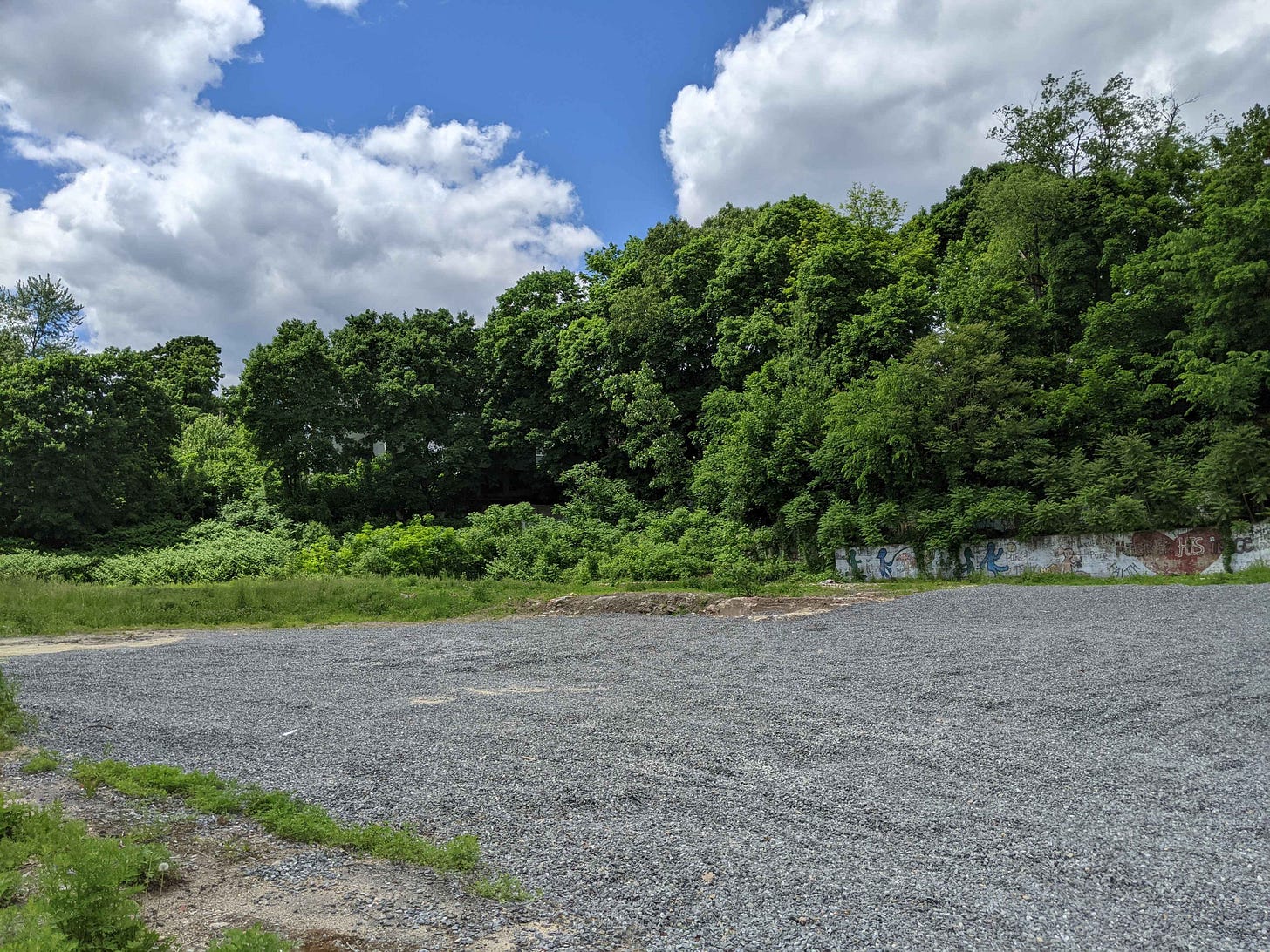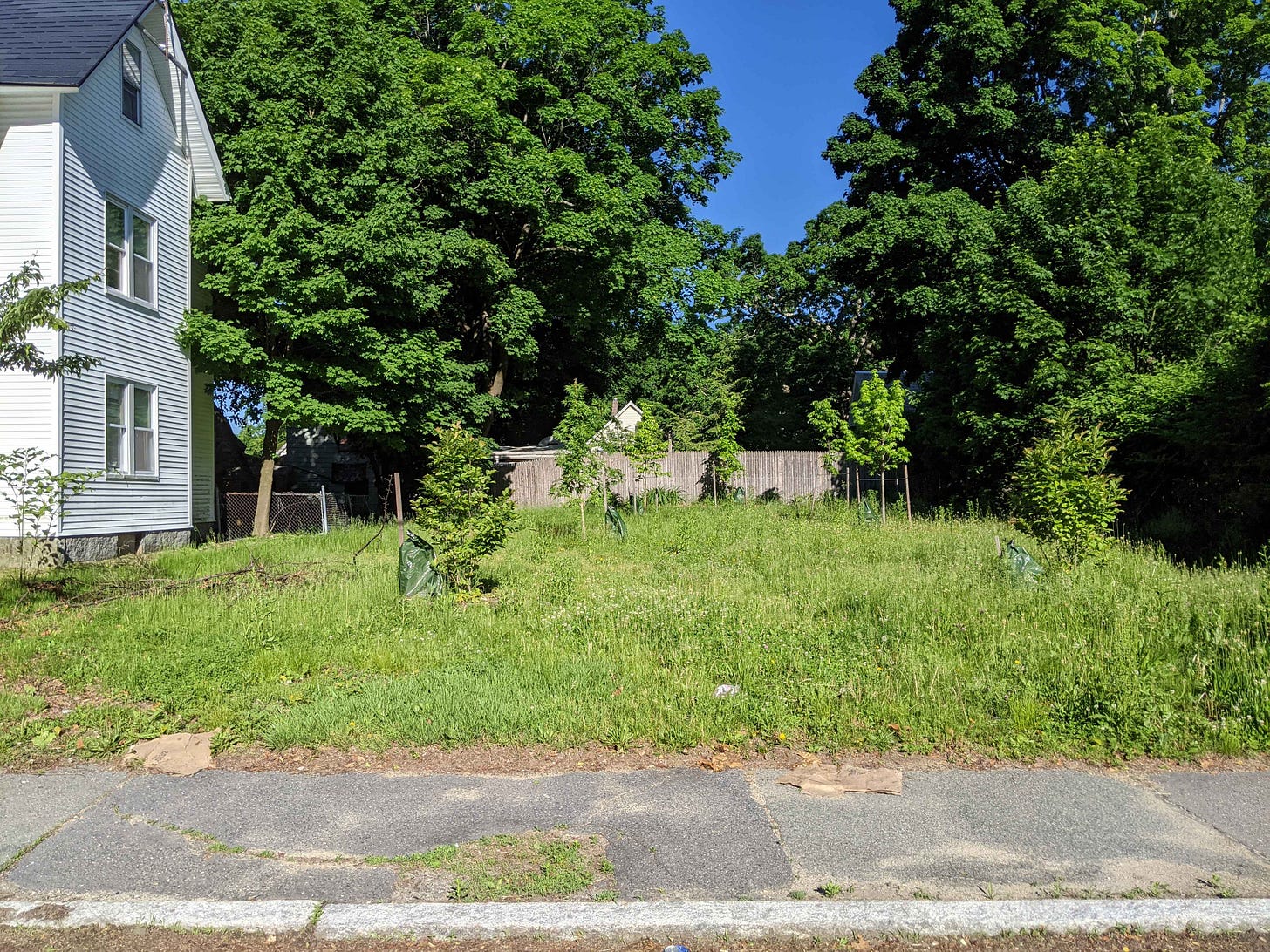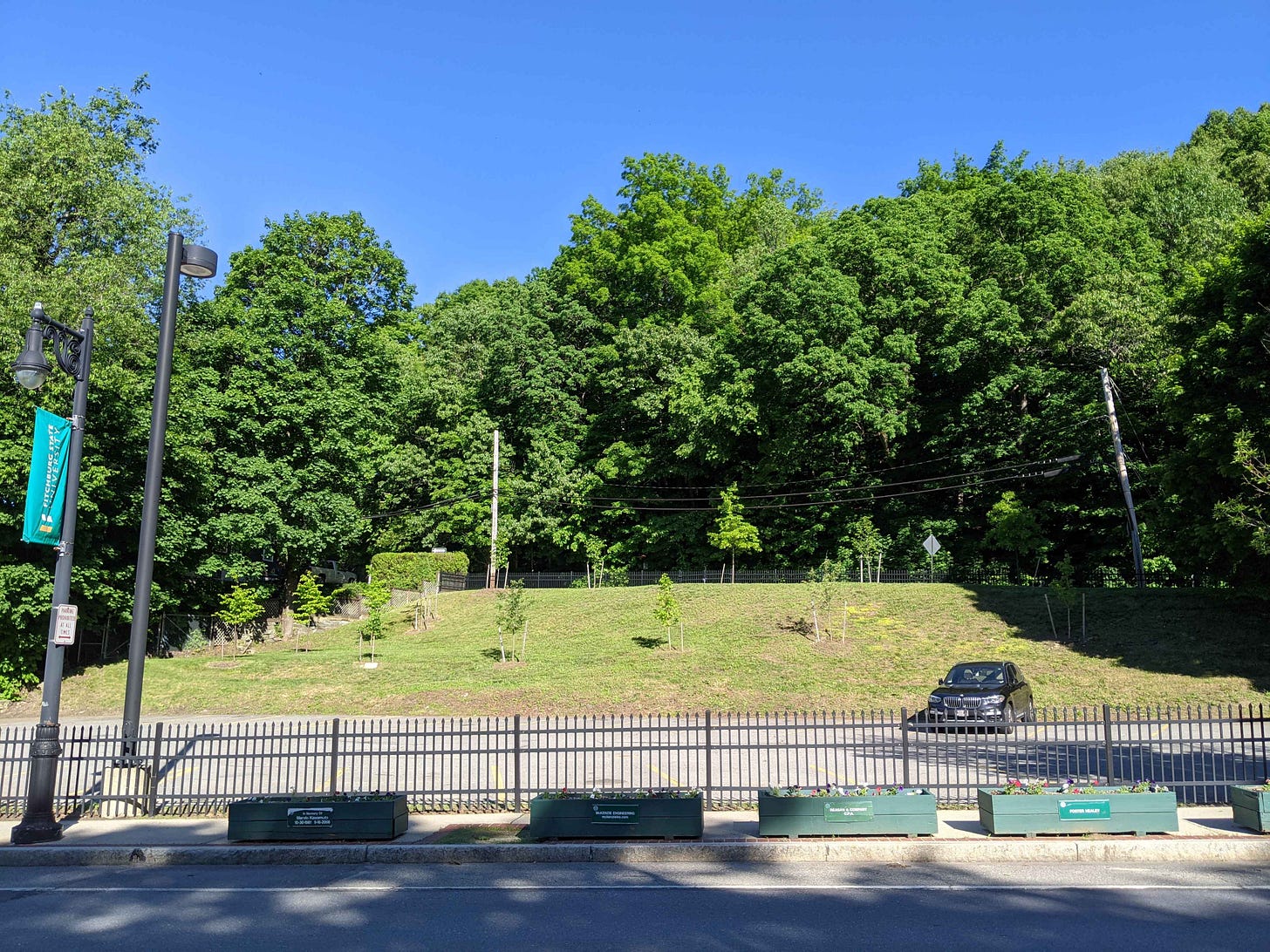Fitchburg has an empty lot problem. All over downtown there are big open fields of grass and gravel where buildings used to be. These lots are entirely unproductive — they provide no homes, employ no workers, pay no taxes, and offer no services. They are not used as parks or recreational spaces. The land is not even allowed to go wild and provide habitat for plants and animals. All they serve to do is space out the city with non-places, empty areas to walk or drive past on your way to somewhere else.
Let’s take a look of some of the most prominent lots, their histories, and how they might be used in the future.
Here is the lot at the corner of Main and Day Streets, right on the north side of the Water Street Bridge. It is immediately adjacent to the Fitchburg Intermodal station and located, for all intents and purposes, right in the middle of town. This site was previously used for a mental health clinic before being shut down in 2012 and demolished in 2015. Today it is an empty field, exposing the parking lot behind the Hotel Raymond apartment building and the gospel side of the Rollstone Congregational Church. There are renders available of a luxury housing development that could be built on the site in the future.
This lot between North and Snow Streets was sold in 2021 to a residential developer named Bill Krikorian. As of 2022 it has been slated for a luxury apartment building with 156 homes, 161 parking spaces, and space for retail. Though the site is adjacent to Fitchburg State University, it remains to be seen whether the new-build apartments will actually be affordable to local students, as opposed to the ordinary multifamily houses north of Main Street that already lodge many student renters. The development would swallow a section of Cherry Street already closed to car traffic, further isolating North Street from the surrounding neighborhood.
There used to be a 47-unit apartment building on this lot before it burned down in 2011. It was called the Johnsonia and was a classic example of early 20th century brick architecture. It has not been rebuilt in the decade since — the fenced worksite in the picture below is storage for materials, not a construction site. This lot contributes another non-place to the empty storefronts and abandoned buildings on main street. The once prosperous city block now has its most prominent corner missing, providing an open canvas for two large murals. As of 2022, the city is still seeking developers.
An abandoned truck factory sat on this lot until it was demolished in 2006. It was the subject of a recent brownfield assessment that determined the soil contained contaminants of concern above acceptable levels. It was recommended that the contaminated soil be transported offsite and a cap of clean fill be put in place. The site is located on Lunenburg Street and zoned for neighborhood business.
Each of these empty lots presents its own difficulties in put to future use. Any use, however, would serve the city better than continued vacancy. Even a luxury residential development, unaffordable for working-class people, may house hundreds of yuppies — and keep them from taking up precious low-rent housing. There is hope that all of these lots can be redeveloped into homes, workplaces, and social spaces within the decade.
However, as the empty spaces downtown face prospects of new construction, there is one neighborhood where empty spaces are being deliberately manufactured: The premises of Fitchburg State University.
Just last year, for example, this field behind Makarios Kitchen was cleared of buildings and planted with grass. Previously there was a six-bedroom duplex and a four-bedroom single house here. Now this pair of lots is home only to rabbits.
During the winter, these sidewalks on the corner of Pearl Street and Myrtle are covered with ice, as there is no adjacent resident to shovel snow. According to the city, the owner of the property is responsible for clearing snow off of the sidewalk. However, I doubt that the school is eager to take up that responsibility.
On the left side of Myrtle Avenue there is a bench and a plaque commemorating the triple-decker house that once stood there (and implicitly telling you that another one will not be built). On the right side of the street there is a pile of rubble where a squat two-story brick building stood until it was demolished in 2020.
Here, on the neighborhood side of Highland Avenue, there is a grass field with saplings. The two-flat house here was demolished in 2011 and acquired by the school two years later. What happened to this lot is a mystery to me, although today it is pleasantly used by the local community to feed neighborhood cats.
There are even more fields and saplings on the hillside between Pearl and North streets, above an FSU parking lot. There used to be houses here. While the land for the current parking lot on North Street was acquired through eminent domain, the opposite strip of land on Pearl and Snow Streets was acquired over the years starting in the late 1990s. In the past the school planned to build a multilevel parking complex on the land.
The remaining residence on this hill is occupied by a homeowner who watched his neighbors disappear over the last decade. The vacant duplex next door once housed students and is now slated for demolition by university contractors. Further down Snow Street is a lone three-flat, both of the abutting properties torn down.
Much of this empty land is owned by a tax-exempt charity called the FSU Foundation Supporting Organization, Inc. As the name implies, it is a satellite of the private nonprofit run by the University. The Supporting Organization manages “real estate and related improvements” for the benefit of the school.
Buying up homes, evicting the tenants, and flattening them to bare grass is a dubiously charitable venture at best. Most likely the school demolishes all of its unused lots to save money on taxes — Property taxes are levied based on the assessed value of a lot; an empty field is cheaper to own. An institution that acquires unused real estate is incentivized to demolish. Historical reformers like Henry George once proposed that improvements be exempted from assessed value; only the land value would be taxed to avoid this exact incentive. Though a truly livable world will require more fundamental change than an adjustment in the tax code, George was right in his statement that “everybody works but the vacant lot.”
With each new demolition, there is one less house for townies and students to rent. Each bedroom destroyed represents one more unit of unmet demand, one more local worker forced to commute into Fitchburg from out of town, one more car in traffic. It means less tax revenue, fewer neighbors, fewer consumers. It is unthinkable that homes in the middle of a city should be cleared out while Massachusetts is facing a housing shortage, yet that is what is happening in Fitchburg.
You can see properties owned by the school and its adjacent charities on the city property map. The State University owns a lot more than just these few lots — there are vacant homes on Pearl and Highland avenues, an empty strip along North Street, and a few parking lots that take up entire city blocks, with some demolitions for parking as late as 2012. There is a clear, steady trend: as time goes on, the school will continue to acquire and demolish homes. The university neighborhood is becoming more sterile, less urban, and less affordable. If this neighborhood is to remain functional, the trend must not only stop — it must reverse. Fitchburg needs its small-lot houses, even in the vicinity of a great university.













